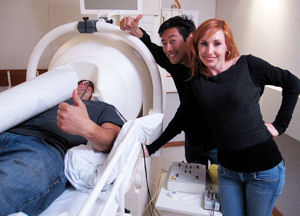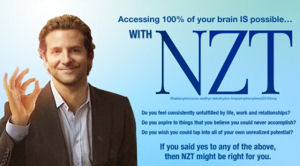A Skeptic's Take on Limitless
Films, books, television, and video games often have to take liberties with the real world, and nobody should ask that they all be completely accurate about everything. However, too many people take these things at face value and walk away believing stuff that is flat-out untrue or illogical. "A Skeptic's Take" is an effort to clear up some of the most pernicious myths in pop culture, not to disparage good entertainment, but to help reinforce the fact that there is a definite dividing line between reality and fiction.
 | | Whether or not it's good fiction is up for debate, but is it good science? |
In Limitless, Edward Morra (Bradley Cooper) is a writer who comes across a drug that gives him remarkable intelligence, cognitive powers, and skills. As exposition in the movie helpfully explains, we humans only use about twenty percent of our brains, and the drug, NZT, allows Morra to use the full hundred percent of his mental potential. This notion--that we only use a small portion of our brains--is not an altogether new one, having been used in other movies like The Lawnmower Man, in television shows like Heroes, and in several stories and books, including The Dark Fields, the novel upon which Limitless is based. Though the exact percentage varies, the concept has been used so often that most people these days believe it. Unfortunately, it is completely untrue.
With the advent of modern brain imaging, especially things like PET scans and functional MRIs, we have learned that there is not a single corner of the mind that is being unused at any given moment. While some parts of our brain may be more active than others, no part ever completely stops working. This had led many, including the Mythbusters, to conclude that the idea that the vast majority of our neurons are being wasted has been definitively disproven. But where did the myth even come from, and why do so many of us still believe it?
Over a hundred years ago, an American psychologist by the name of William James outlined a principle that would be known as "the law of reserve energy." According to James, there is a hidden storehouse of mental and physical energy inside each of us, and that, if tapped, it could greatly enhance our lives. One of James' students, Boris Sidis, used the principle to raise his own son, the famous William James Sidis, whose IQ was estimated at a ludicrous 250-300. William Sidis graduated from Harvard at 16 and became a notable eccentric who was put in an insane asylum for being a self-described consciencious objector to the World War I draft, an atheist, and a socialist (though his political views later morphed into something akin to modern-day libertarianism). In the foreward to the influential 1936 book How to Win Friends and Influence People, Lowell Thomas wrote, "Professor William James of Harvard used to say that the average man develops only ten per cent of his latent mental ability," though there is no corroborating evidence that William James ever articulated an exact percentage.
 | | And then they blew up the MRI machine with fifteen pounds of C4 |
It is important to note that, in the early Twentieth Century, neurologists had a very primitive understanding of the brain. Research into brain damage at the time often came to confusing conclusions about how certain parts of the cerebrum work, largely due to the fact that neuroplasticity--the idea that neurons can be reappropriated in the advent of neurological damage--hadn't been accepted yet. (Ironically, the concept of neuroplasticity was first articulated by none other than William James.) Many psychologists of the time thought that certain parts of the brain were largely useless because damage to them didn't seem to have many negative effects.
It's easy to understand why when you consider things like Phineas Gage, the most famous early case of severe brain injury. Gage was a man who, in 1848, through his own wacky hijinks, wound up with a railroad spike through his head. After destroying almost all of his left frontal lobe and miraculously surviving, Gage's mental faculties remained mostly intact (though his behavior and temperament were radically altered). This eventually led to discussions about brain localization and how much of our identity is defined by our neurons, but it also lead many early neurologists to conclude that much of the brain is expendable.
Even now, we are often at a loss to comprehend how people can survive such widespread damage as Gage's. No one doubts that the brain has more than its fair share of unknowns. There are still plenty of questions about the nature of glial cells, the relationship between different types of neurons, and how synaptic functions lead to consciousness. We are light years ahead of where we were in the time of William James, but our understanding of the brain is still pretty primitive.
 | | The curious case of Phineas Gage, pictured here, is what early neurologists considered state-of-the-art research |
In a subject so shrouded in mystery, it is only natural that a myth like the one in Limitless can fester. Lowell Thomas' "ten per cent" seems perfectly reasonable given the attitudes of the time, and when even modern experts in the field are forced to admit that we know less than we don't know, it is understandable how people can so readily believe it today. When a myth like that one achieves a certain saturation point, it takes an extraordinary amount of evidence and time for it to fall out of favor. This is why people still believe it, even though PET scans and functional MRIs are hard to refute.
There is more evidence against the myth, too. Arguably as compelling as modern brain imaging is evolutionary biology. The human brain, when compared to the brains of other animals, is proportionally enormous. One of the main reasons children are born when they are, earlier than the children of other mammals, is so that their heads will be small enough to fit through the birth canal. The human brain also uses a huge amount of energy in the form of oxygen, metabolized sugar, and other nutrients. On average, a human's brain only accounts for two percent of his or her weight, whereas it utilizes over twenty percent of the body's energy. Something as large and costly as that has intense selective pressure to be as efficient as possible, and from an evolutionary perspective, it would never come about if only ten percent of it were being used.
 | | It's possible without NZT, too, assuming you don't have a railroad spike plunged through your skull |
That's not all, either. Though poor, misunderstood, or misinterpretated research into brain damage in the early Twentieth Century may be largely responsible for the myth's existence, modern research into brain damage is much more sophisticated. The brain does have an incredible ability to compensate for damage, but it is a fact that there is no single part of the brain that is truly expendable. Every single neuron serves a purpose, and those that aren't used are either reappropriated or will quickly atrophy. Though we may not fully understand the brain's every function or connection, we can be certain that our lack of understanding does not reflect a lack of purpose. Even if it did, we definitely understand more than ten--or even twenty--percent.
This is not to argue that science won't one day be able to create a drug that vastly improves human function. While William James' reserve energy theory isn't as well-regarded today as it was a hundred years ago, it's still plausible that there is more efficiency to be squeezed out of the human body and mind. Evolution might one day provide the answer, but it is far more likely that technology will provide the next leap in human excellence through artificial means. It could be in the form of advanced pharmacology, nanotechnology, cybernetics, or some other fantastical fringe of scientific experimentation, but it seems reasonable to conclude that something like NZT will one day exist. However, since it is couched in the myth that we only use a fraction of our brain, Limitless doesn't stand up to skeptical scrutiny.
-e. magill 6/1/2011
|
|